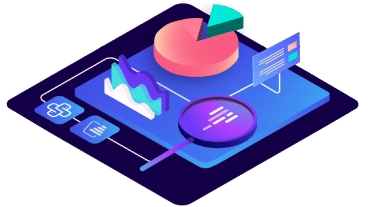Qualification for the job role as Business Intelligence Analyst

With the certified online training to become a BI Analyst - Focus Power BI, you get started in (self-service) Business Intelligence. You will build up practical expert knowledge for SQL and relational databases. We teach you how to get the most out of relational databases and avoid common mistakes with the latest SQL best practices. You get the most important basics for BI with Microsoft Power BI at hand.
Using the best practices of the Power Query Editor as well as advanced use cases, you will create meaningful visualizations, which you will prepare in target group-oriented dashboards and present in an easy-to-understand way with the help of data storytelling. You will finish the online course with a company-relevant final project on flight delays at Los Angeles International Airport and, upon successful completion of the career path, you will qualify for a job role as a (Junior) BI Analyst, Business Analyst or an analytical job role in a specialist department as a Reporting Analyst.
The advanced training BI Analyst - Focus Power BI is suitable for anyone who wants to learn Microsoft Power BI as a business intelligence tool and use it professionally. You should have an enthusiasm for logical thinking and the visual preparation of results. The training is suitable for career changers and the ideal introduction to business intelligence to become a Power BI Analyst or Developer or Business Intelligence Analyst or Consultant.
Chapter 1: Introduction to Relational Databases
The first chapter introduces you to the topic of databases. You will learn what databases are, where they are used, and why. You will understand how relational databases are constructed and familiarize yourself with their advantages and disadvantages. You will learn to write SQL queries independently to extract company-relevant information from relational databases. In the first practical project, you will apply the previous learning content and filter data using Boolean logic.
Chapter 2: Advanced SQL
In the second chapter, you will refine both your theoretical and practical knowledge. You will learn to group, sort, and join data with your queries. Additionally, you will learn about Subqueries, which provide new filtering options. In the second practical project, you can reinforce everything you've learned so far.
Chapter 3: Advanced Database Design
In the third chapter, you will focus on the structure of relational databases. To better understand their construction, you will delve into database design and learn about normalization rules. To put your knowledge into practice, you will learn how to create or modify tables and data. In the third intermediate project, you will design a database and implement your design practically.
Chapter 4: SQL in Practice
The final chapter focuses on the culmination project. Here, you will independently analyze a completely new database - from the initial exploration to the final query. We will introduce you to two more important concepts that frequently arise in everyday SQL work: you will learn how to use Common Table Expressions (CTEs) to maintain clarity in complex queries. You will also deepen your knowledge of analytical functions to create rankings or calculate running totals over extended periods. Additionally, you will gain an overview of how to apply SQL in practice after training and what tools are available for you.
Chapter 1: Introduction to Power BI
In the first chapter, you will learn why data-driven decisions are important and what the workflow of data analyses looks like. You will learn about the most important basic functions of Microsoft Power BI - including data, model, and report views as well as the filter functions. You will load multiple data sets in the Data View to create a data model and your first report.
Chapter 2: Data Preparation and Data Storytelling
In the second chapter, you will learn about data visualization best practices and how to modify and format visualizations using hands-on exercises. Power BI offers numerous visualizations that you can use in reports and dashboards. You will learn how to avoid typical mistakes and get guidelines on how to format graphics in an understandable way. You‘ll then learn how to use the Power Query Editor with Power BI Desktop to process data and link disparate data sources.
Chapter 3: Dashboards and Data Storytelling
In the third chapter, you will learn how to arrange your reports and analyses in dashboards and how to communicate them to relevant target groups in an efficient, easy-to-understand way using the most important principles of data storytelling. You will also learn advanced BI skills. You will learn the basics of Data Analysis Expressions (DAX language). You‘ll learn basic concepts and best practices for incorporating DAX into your reports and learn to write complex DAX code for calculations to generate columns, metrics, and tables.
Chapter 4: Advanced Topics
The fourth chapter focuses on basic concepts of statistics. We will provide you with the best practices for valid statistical data analysis. Finally, you‘ll explore advanced business intelligence methods based on statistics and machine learning. At the end, you will be able to use a cross-page drilldown and perform an influence factor analysis with the help of the drillthrough.
The demand for data experts is high. Around 4 million data experts will be needed in Europe by 2025. In Germany alone, 149,000 IT jobs are currently vacant. The demand for data and AI experts in particular continues to grow enormously.
But a decision for a data career is so much more than just a safe decision for the future! As a data expert, you deal with powerful, socially relevant topics, are a tech professional, and are communicative and creative at the same time. The profession is varied, can be combined with most other professions and offers an attractive salary. And most importantly, with us it can be learned unerringly!
Yes, after successful completion of the training, you will receive a certificate of completion from us that you can show in your job applications. Data Analysts and Data Scientists are desperately sought after in many business sectors. Even without relevant work experience, your chances of finding an entry-level job are good. In addition, there are analysts in almost every industry who have different job titles, but the skills you need are the same as those of a data analyst or data scientist.
Yes, our online training courses are designed to offer you the greatest possible flexibility. In general, we recommend that you plan six to eight hours per week for learning. When you want to schedule this time is up to you and is not prescribed by us. In our career paths, the Data Analyst and Data Scientist course, we offer live webinars where you can ask our mentors questions, but you don't have to attend if it doesn't fit into your schedule.
(Participants in our sponsored training courses are excluded. These must attend a fixed number of hours per week and are obliged to participate in the live webinars).





StackFuel GmbH
Nostitzstrasse 20
10961 Berlin
info@stackfuel.com
030 / 544 533 420
We need your consent before you can continue to visit our website. We use cookies and other technologies on our website. Some of them are essential, while others help us improve this website and your experience. For more information about how we use your data, please see our Privacy policy.
We use cookies and other technologies on our website. Some of them are essential, while others help us improve this website and your experience. For more information about how we use your data, please see our Privacy policy. Here you can find an overview of all cookies used. You can give your consent for entire categories or view more information and select specific cookies.